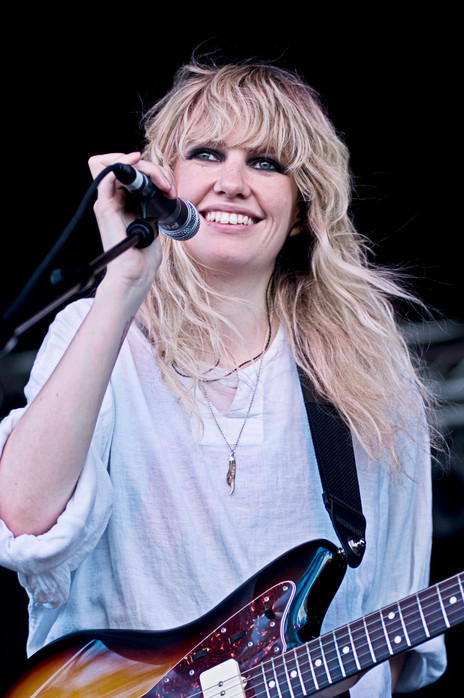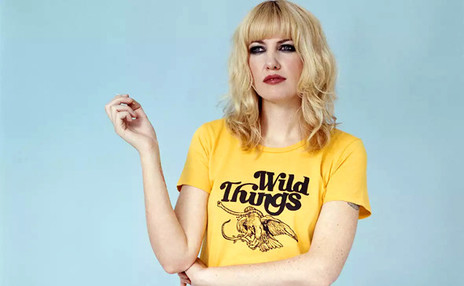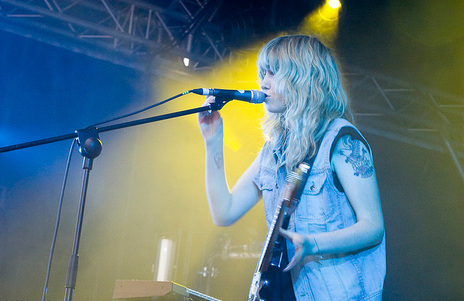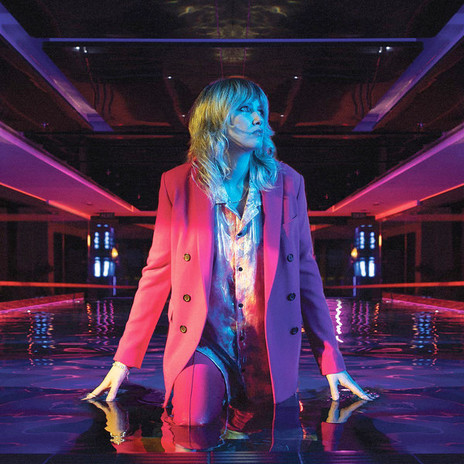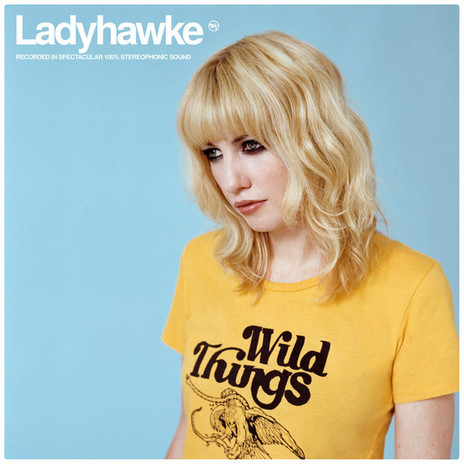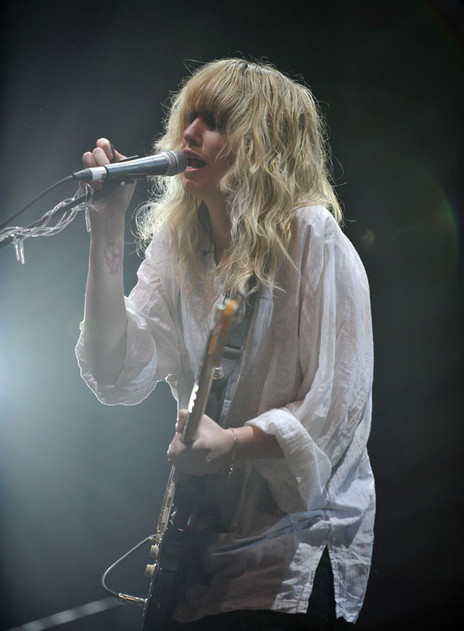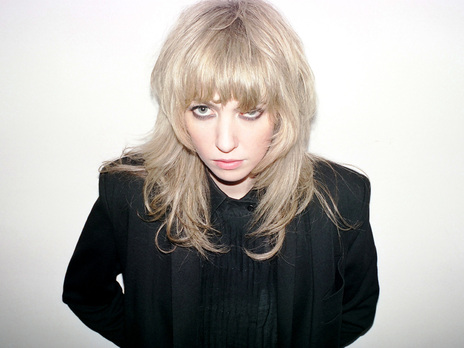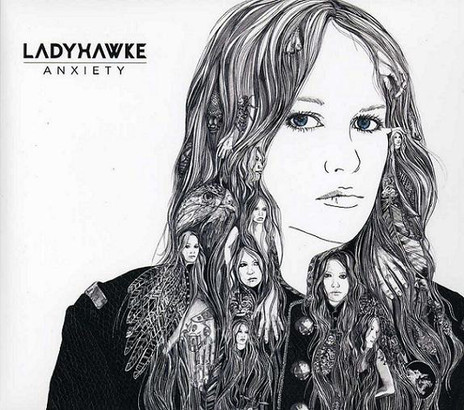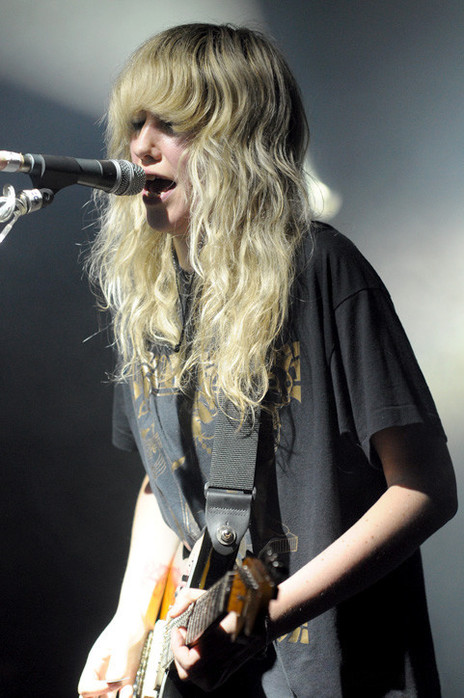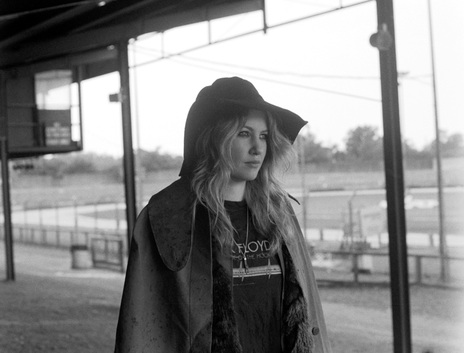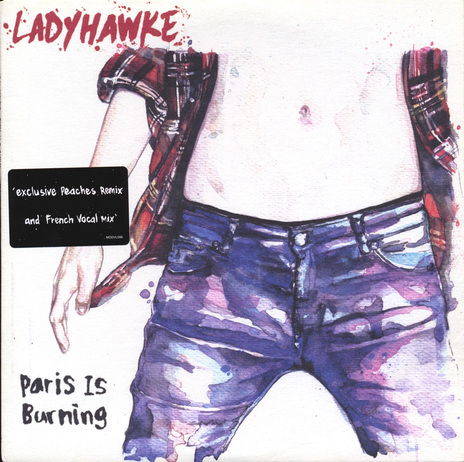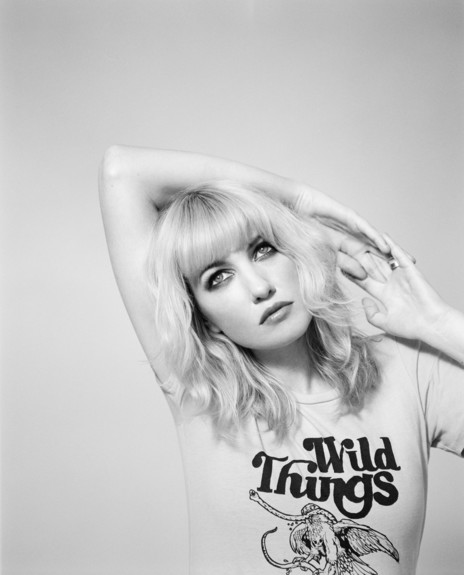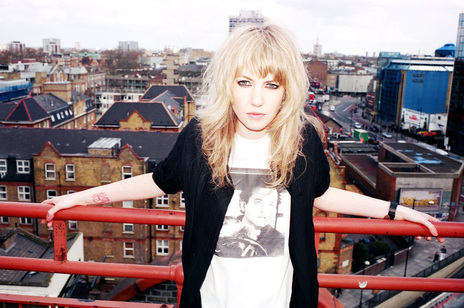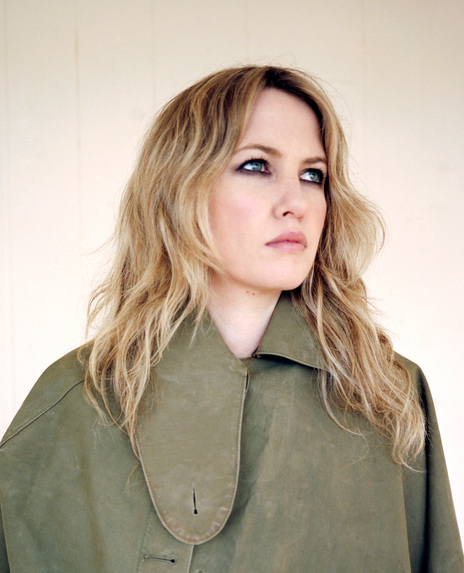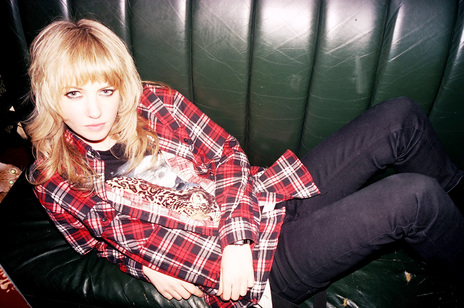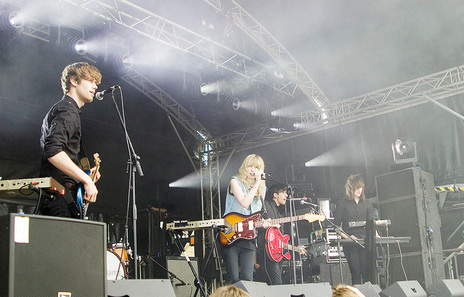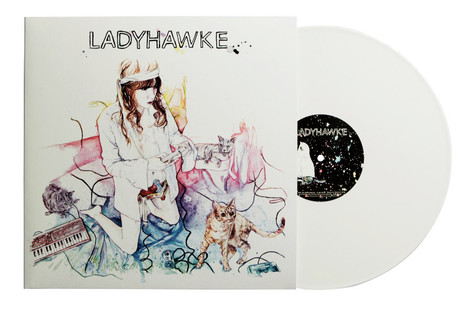It hasn’t always been plain sailing for Pip Brown. At the age of 10 she was diagnosed with Erysipeloid, a disease common in seagulls, but rare in humans. Allergic reactions to medication meant the condition was life threatening, and she fell into a coma. She recovered, and continued to absorb herself in music – unsurprising, as her mother sang and played the guitar, and her stepfather was a jazz drummer. Fast forward a few years, and Brown began performing in bands at Chanel High School in Masterton.
Two Lane Blacktop
Instead of staying in her hometown after finishing school, Brown moved to the bright lights of Wellington, and formed the hard rock Two Lane Blacktop with friends Matthew Harrop (guitars, vocals), Ben Fraser (bass) and Phil Smiley (drums), playing lead guitar and singing backing vocals.
After releasing three EPs – Live (2001), Mechanic Demos (2001) and The Mechanic (2002), they put out ‘The Rat’/‘Hellhound’ (Infidelity, 2003) which gained airplay in Australasia, and was on English DJ John Peel’s playlist. Later that year, the band toured the USA, playing in LA and New York (including a gig at CBGB’s nightclub), before returning to record their unreleased album The Girl (2003). By the end of 2003, Two Lane Blacktop were no more, calling it quits on the eve of an Australian tour.
Melbourne
Not one to stay still, Brown headed to Melbourne, where she met Nick Littlemore, vocalist with Australian band Pnau. They were soon collaborating, calling themselves Teenager. Their style was an amalgam of art rock and punk, with Brown on guitars and vocals, and Littlemore on keyboards and vocals. After two singles, ‘Pony’ (Timberyard, 2006), and ‘Bound and Gagged’ (Timberyard, 2006), the duo released Thirteen, which was recorded in Paris, London, Sydney, New York and LA, and featured musicians such as Lee Ranaldo from Sonic Youth, and Roland S. Howard. To promote Thirteen, they toured with an extended band line-up, but afterwards Littlemore returned to Pnau. There were no hard feelings, and Brown provided vocals for one of their most well known songs, ‘Embrace’ (etcetc, 2007), before finding her solo voice as Ladyhawke.
Influences
The name “Ladyhawke” came from the 1985 Michelle Pfeiffer film, giving Brown a cool one-word moniker, and implying a supernatural ability. For this new incarnation of her career, she took inspiration from 80s superstar musicians and songwriters Stevie Nicks, Kim Wilde, Pat Benatar and Cyndi Lauper – women who valued style as much as substance. To temper these influences, she made her image more androgynous, though still feminine: jeans, T-shirts and boots – her stylistic nod to the 80s being eyeliner, and layered blonde hair. After demoing material at home, Brown (as Ladyhawke) released ‘Back of the Van’ in 2008. The song became an online hit, and soon she found herself with a major record deal, moving to the UK later that year, building her fan base through sold-out gigs in hip venues. This was only the start. Singles ‘Paris is Burning’ (Modular, 2008), ‘Dusk Till Dawn’ (Modular, 2008), and especially ‘My Delirium’ (Modular, 2008), gained her an ever increasing audience, and she could count Kylie Minogue and Courtney Love as fans. The striking artwork on the singles was by close friend Sarah Larnach, who Brown met while living in Melbourne. Larnach also illustrated and helped design both Ladyhawke album covers.
Debut album
‘Ladyhawke’ went platinum, and straight to No.1 in NZ, and charted at No.16 in the UK and Australia, going gold in both countries.
Her debut album, Ladyhawke (Modular, 2008), was co-written with producer Pascal Gabriel among others, and was a synth-filled, hook-heavy record. The album was a success, and reaped the rewards for her hard work, giving Brown critical acclaim, and making her the Next Big Thing – something she wasn’t comfortable with. Ladyhawke went platinum, and straight to No.1 in NZ, and charted at No.16 in the UK and Australia, going gold in both countries. 2009 was definitely the year of Ladyhawke, and was capped off by Brown’s success in winning six NZ Music Awards, including Album Of The Year. She also won two ARIA (Australian Recording Industry Association) awards – Breakthrough Artist of the Year in both single and album categories. Along with these wins were nominations for Brit, NME and MTV Australia awards. After these successes, Brown toured the USA in 2010 with Norwegian musician Ida Maria, a tour sponsored by celebrity blogger Perez Hilton.
Brown has come under scrutiny for her social difficulties and reticent manner – one of the effects of her mild form of Asperger’s syndrome. She is open about the condition, and the accompanying difficulties, telling Paul Lester from The Guardian, “It was the reason I was so solitary. I’d say completely inappropriate things. The other kids thought I was a weirdo.”
After a significant hiatus to recover from exhaustion, Brown collaborated with Junica (Nick Brinkman) on his single ‘Living in My House’ (Warner, 2011). She also worked with Tim Burgess from The Charlatans on the unreleased ‘Just One Kiss’ – though remixes of this track have appeared online.
Sophomore release
A formal announcement came in 2011 that she was recording her second album, again co-written with Pascal Gabriel. Anxiety was released in May 2012, four years after Ladyhawke. A darker, rockier album, it tackled her Asperger’s head-on in the very personal title track, and dealt with issues of her personal anxiety and nervousness. The influences were different too, Brown telling the NME, “I listened to a lot of guitar rock when I was writing it, stuff like Pixies, Blur, Nirvana and I’ve always wanted to make a guitar record. There’s no synth, but there’s some organ.” She considered the album an amalgam of everything she had listened to over the years.
Unlike its predecessor, Anxiety’s three singles did not chart locally, though the first, ‘Black And White And Blue’ (Modular, 2012), had a stylish video inspired by the film Eyes of Laura Mars, and received high rotation on music television. Anxiety wasn’t a runaway success like Ladyhawke, though it debuted at No.12 locally, and went Top 20 in Australia and Top 40 in the UK. To promote the album, she toured internationally, and her London show at Shepherd’s Bush Empire sold out in five minutes.
In 2013, Brown announced she was back in the recording studio and in June 2016 she released the third Ladyhawke album, Wild Things.
--
In 2013, Brown announced she was back in the recording studio – but an entire album was scrapped before a new release. “The material didn't feel like me,” she told the NZ Herald in 2016. “It felt too dark or something ... I’ve never released anything I’m not proud of. That’s important to me.”
Brown had gone through a major reckoning in her personal life, and the record didn’t reflect the light she had reached at the end of the tunnel – namely sobriety and marriage. Following the Anxiety tour, Brown was forced to come to terms with her drinking problem. “I felt disgusted, like: ‘What the fuck am I doing?’” she told The Guardian in 2016, “I’d made my career come to a grinding halt because I was not doing anything; I was wallowing in my own shit and I was drinking too much, and I felt so bad. I felt the worst hangover coupled with depression and aching and felt horrible.”
Brown stopped drinking and married her girlfriend, actor Madeleine Sami, in 2015 – two life-changing milestones that inspired her to explore the lighter side of Ladyhawke, and thus abandon her first attempt at album three. Brown and Sami settled in sunny LA, another major change that would come to influence her music. Brown told NZ Herald, “I feel good for the first time in 10 years. I actually have a clear mind! I have a wife. I feel stable. That is what I’m celebrating.”
In 2016 Wild Things finally arrived, Ladyhawke’s most traditionally pop album to date. The polished synth-pop was co-produced by Scott Hoffman, otherwise known as “Babydaddy” of Scissor Sisters, and Brown’s close friend, producer Tommy English, who also played a key role in the songwriting.
In pure pop fashion the singles – ‘Wild Things’ and ‘This Is Not A Love Song’ – were supported by glossy, high production-value music videos that continue the 80s theme of the record. Wild Things is a notable departure from Ladyhawke’s signature, decidedly thornier sound and critical reception was mixed. Whereas Q Magazine found it “likeable as it is cutting edge”, to Pitchfork it “could have easily been created by a computer tasked with making generic 21st-century chart music”. There was not much in between those polar extremes.
The conflicting responses confirmed that Brown had taken a bold new direction, but she already knew that. Speaking to RNZ’s Jesse Mulligan in 2017, she reflected that her work has always been motivated by her mood. “I’ve never been able to churn out album after album. I’m really dictated how I feel, how I’m feeling in my head. That’s why it’s taken me ages really.”
Wild Things enjoyed a tour of the US, the UK, Australia, New Zealand, then back to the US again for a second tour. The earnest and feel good nature of the album made it well suited as a soundtrack, and songs starting popping up in everything from commercials, to video games to television shows.
Brown further solidified her pop culture presence with a nomination for Best NZ Act at the MTV European Music Awards (won by Broods), and an appearance in an Air New Zealand safety video – luckily, one of the good ones. Life slowed down in late 2017 when Brown welcomed her first child with Sami, a daughter.
Brown tinkered on a few projects throughout 2018 – singing on ‘Never Dance Along’ for Australian group Crooked Colours, covering ‘Break in the Weather’ by Jenny Morris for the APRA Silver Scroll awards night, and coordinating a special 10-year anniversary for her debut album. In May 2019, Ladyhawke was re-released, having been lovingly remastered on white vinyl. The album included a previously unheard track, ‘Private Broadcasts’, as well as plenty of behind-the-scenes stories and titbits shared by Brown during promotion. Later that year ‘Colours in the Dark’ – another song that did not make the final cut back in 2009 – was separately released, accompanied with characteristically cool cover art by Sarah Larnach.
Time had only solidified Ladyhawke as one of New Zealand’s great albums of the early 2000s, as well as an extremely significant moment in Brown’s career. Looking back on that era, Brown noted how hard she has worked to overcome the anxiety that plagued those early years. It stopped her from engaging with her fans, to the point of not giving audience members eye contact at shows. “I wanted to but I just couldn’t, I found it really hard to talk to people,” she told Mulligan in 2017, when she returned to live in New Zealand. “Now when I do shows, when I go on tour, I go out and I sit at the merch desk and I meet people … it was really hard for me back then, but I’m trying really hard now to be, like, engaging,” she said, laughing.
2020 brought with it all the same challenges faced by musicians across the Covid-stricken world: cancelled gigs, travel restrictions and other coronavirus related road blocks. Despite setbacks, in September 2020 Brown announced on social media that she is working on an album at home.
– Updated by Rosie Howells, October 2020
--
Update:
In 2020, Ladyhawke was reunited with Nick Littlemore for the Pnau single ‘River’ which they’d written and recorded together in his studio in LA, with him encouraging her to sing the chorus as loud as possible. It became an online hit with over 8 million streams. In the intervening years, Littlemore had also become one half of the incredibly popular duo, Empire of the Sun, but he worked on a track with Brown for her next album.
While in LA, Brown also met up with her friend and collaborator Tommy English to write tracks at his studio. Back in New Zealand, she also worked with hit producer/songwriter Josh Fountain (Leisure, Benee) and she recorded instruments and vocals for the album with engineer Jeremy Toy (Opensouls, She’s So Rad).
The first single from the album was ‘Guilty Love’ which featured another internationally successful local act, Broods. Brown and singer Georgia Nott had met up at Tommy English’s studio in LA and shared their experiences of growing up in a religious setting, which had led them to later push back against the stereotypes of what a woman should be which were presented to them. The song topped Triple J’s most played list in Australia and became another million streamer for Ladyhawke in advance of the fourth album, Time Flies (2021).
– Update by Gareth Shute, 2023
